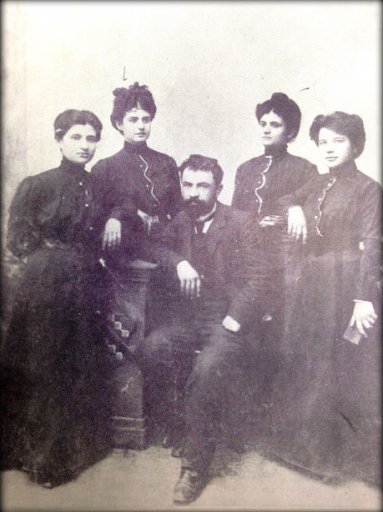
The fedayees of the Armenian revolutionary movement still loom large today, their heroism and bravery having made an indelible mark on the pages of our people’s history. Unfortunately, all too often, we focus only on the male fighters and revolutionaries of this period. From this reality, some may draw the conclusion that the militaristic aspect of the movement resulted in the exclusion of women from holding important positions during that time. However, the truth is quite the opposite: innumerable women were instrumental in the success of Armenian revolutionary organizations. In fact, the renunciation of revolutionary struggle and transition to peaceful Diasporan life were far more detrimental to women’s importance and standing within Armenian organizational life and society.
This two-part series will discuss the role of women as Armenian revolutionary leaders and organizers; examine their role in secret revolutionary activity; the factors which limited their participation; and the debilitating effects of the transition to Diasporan life on Armenian women.
There were many female leaders in the Armenian Revolutionary Federation (ARF), especially in the first few decades of the party’s existence. One notable figure was Zarouhi Deroyan (Zhenia), who served on the Central Committee of Vasbouragan (Van). Following the great ideal of revolutionary leadership, she not only engaged in tasks related to organizing and planning, but she also was involved in arms transportation and intelligence gathering. In fact, she was so dangerous to the Ottomans that before beginning their attacks and massacres in Van, the first thing they did was arrest Deroyan. Rather than imprisoning her in Van where she could be broken out by her ARF comrades, they exiled her – first to Constantinople and then to Jerusalem, where they sent the most dangerous and influential revolutionaries (Catholicos Khrimian Hayrig, for instance). Both Catholicos Ormanian and the ARF were actively engaged in trying to free Deroyan from exile; she was finally able to return after the overthrow of the Sultan in 1908.
Unfortunately, during the Bolshevik invasion of Armenia, much of Armenia’s intellectual and military leadership was either decimated or forced into exile. This reign of terror was not curtailed by the boundaries of gender: female ARF members and leaders were imprisoned and martyred alongside their male counterparts, including Natalia Amirkhanian, a longtime ARF organizer and ideologue. Amirkhanian first entered the revolutionary fray when she joined the Russian socialist Narodnaya Volya (“People’s Will”) secret terror organization. In 1882, when Amirkhanian was only 19 years old, the organization began to fracture over ethnic divisions, so she joined Armenian “Narodnik” cells. Amirkhanian joined the ARF just after its founding in 1890 and remained a committed member until her death. She moved to Karakilise (modern-day Vanadzor) to bring the revolution to provincial Armenians. It’s where she was elected year after year to the ARF Committee (Gomideh) until the Bolshevik invasion of Armenia and fall of the Armenian Republic.
The Bolshevik invaders arrested ARF members across the whole of Armenia, subjecting them to the harshest of conditions. When the anti-Soviet February Uprising of 1921 began, the Bolsheviks began to execute political prisoners en masse; this occurred both in Yerevan, where hundreds of prisoners were axed to death and in provincial jails like Karakilise. On February 16, 1921, two days before the Armenian nationalist rebels would liberate Yerevan, Amirkhanian was murdered alongside her comrades in Karakilise by Bolshevik executioners. Even in her old age and facing certain death, Amirkhanian did not waver in her convictions and love for her party.
One woman who reached some of the greatest heights in the party was Daria Goloshian, an early member of Kristapor Mikayelian’s “Young Armenia” and the ARF. Like Amirkhanian, Goloshian was also involved in the Narodnik movement before Armenian revolutionary organizations were formed. Unfortunately, very little information exists about Goloshian. What is known is that she served as treasurer and accountant for both the ARF Bureau and Central Committee of Tiflis in the early years of the party.
Of course, when discussing the role of women in leadership, it is impossible to forget the Matinian sisters: Natalia and her more famous sister, Satenik. Natalia Matinian joined the ARF in 1890 and was a committed, lifelong unger. In fact, she carefully chose her profession – midwifery – so that she would be able to have a cover for her frequent travels and gain access to private spheres. Praised for her secrecy and described as “serious, silent and cold-blooded,” Natalia Matinian carried out many secret assignments for high bodies of the ARF, including the Bureau. Her home functioned as a hub for ARF activities; she also served on an ARF Central Committee for years.
At only 15 years of age, Natalia’s sister Satenik was already an active participant in the efforts to create the union of revolutionary parties that would come to be known as the ARF. After the first ARF World Congress in 1892, Satenik was directed to go to Tabriz in northern Persia, where she would organize the Armenian community and the Armenian women of Tabriz, bringing them out of the female domestic sphere and inspiring them with revolutionary ideals, so that they might, in time, join the ranks of the party.
This was a common endeavor during the first decade of the ARF’s existence and many party women were asked to form female khoumps (groups). These would often start as charity organizations or reading groups so as to operate without suspicion; while men were more free to join revolutionary organizations (especially in places like Persia), women were often trapped in patriarchal familial relations that necessitated the creation of a believable cover for their political activities. These women were eventually pulled from patriarchal families and societies and introduced to politics for the first time. They became integrated into the work of the party and would become the weaponsmiths and planners of the ARF’s secret operations.
This was a particularly difficult task for Satenik because the Armenian community in Tabriz was more conservative than many others, making it hard to penetrate the family structure. Regardless, Satenik was largely successful and able to organize nearly all the women of Tabriz around the revolutionary ideals of the ARF. “The Armenian women of Tabriz, wrapped in black and blue cloaks [chador], rush to the meeting – no one wishes to miss it. All are sitting quietly while Miss Satenik speaks. In that moment, she was the perfect missionary, the personification of ideology, and from the depths of her soul, stories of the miserable and harsh life in the Homeland were springing out. Like a fanatic preacher, she described the hell that was called Turkish-Armenia, where the Armenian people were suffering nationwide.” This description by Abraham Giulkhandanian perhaps paints the best picture of the ideological giant that was Satenik Matinian: a committed ARF member, community organizer, weapons transporter and above all, revolutionary.
Part II of this article will discuss the role that women played in secret revolutionary activities – as saboteurs, bombers, arms smugglers, and so on. In addition, it will delve into some of the limitations and restrictions that women faced in the revolutionary sphere, the dangers of their participation, and the reason why revolutionary activity promoted the voice and role of women, while the transition to a peaceful Diasporan existence was a source of marginalization for them.



Aram this is a well-written, informative, and insightful article. I’m beyond proud. Thank you for sharing our proud history. Sirov, Auntie Nairi
Unger Aram, this is such an eye opening article. Thank you for sharing this. I’ve learned a lot.
Congratulations, Aram! A well-researched, timely and necessary article. I am impressed, and I look forward to part II. Abris, Aram.